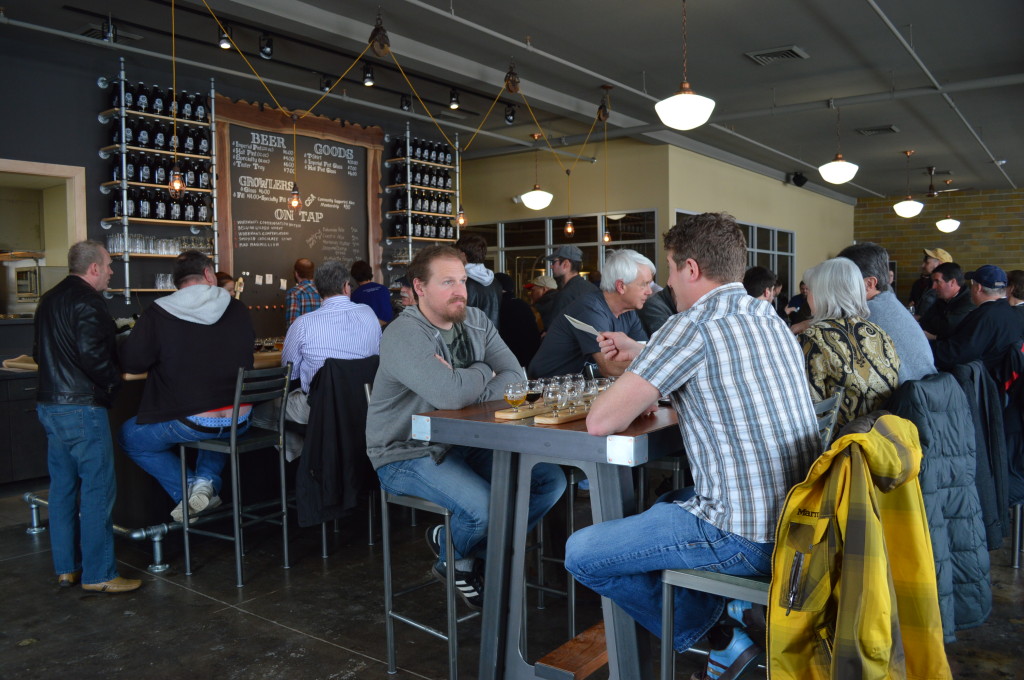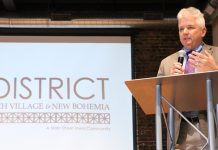
By Dave DeWitte
CEDAR RAPIDS – A new Alliant Energy program introduced this year is helping businesses like the new Lion Bridge Brewing Company in Czech Village reduce their electric consumption by installing more efficient lighting technology.
The Turnkey Lighting Program was one of many energy efficiency topics discussed at the Alliant’s 2014 Energy Summit, which brought close to 200 commercial customers and Alliant business partners to the Cedar Rapids Doubletree Hotel and Convention Center on May 6.
The program pays customers 0.14 cents per kilowatt hours saved, up to 75 percent of the total project cost for a lighting installation, according to Amy Stevens of CLEAResult, the program contractor that worked with Lion’s Bridge.
Lion’s Bridge is a 10-barrel microbrewery that opened March 5 at 59 16th Ave. in Cedar Rapids. Building owners George and Janelle McClain wanted to keep the vintage look of the lighting in the 1938 grocery building in which their son, Quinton, operates the microbrewery.
To access the program, the McClains called a lighting contractor for a free evaluation, which resulted in a recommendation to install 135 new fixtures and nine light controls they would not have had in the old facility.
The efficiency of the lighting solution is expected to result in a favorable electric bill “swing” of $6,000 annually, Ms. Stevens said. Alliant paid $8,600 toward the installation cost, resulting in a customer balance of $23,964 that will be paid off in less than four years, making the future savings free and clear to the microbrewery.
“We were able to do that while still maintaining the historic integrity of the building,” Ms Stevens said.
Because the lights were specifically designed for the restaurant, Ms. Stevens said they cost significantly more than typical installations. Such installations typically result in a payback time of two to three years, Ms. Stevens said.
The program is limited to businesses that occupy less than 20,000 square feet of space and have electric expenditures of under $50,000 annually. It is a new element of the five-year Alliant energy efficiency plan approved by the Iowa Utilities Board. Such plans allow the utility to recover the cost of programs that provide incentives to save energy through its customer rate structure.
Direct energy savings are just one of the reasons for using the program, Ms. Stevens said. Better lighting can enhance the sales floor of a business and also improve worker productivity, she added. Many programs involve “delamping” or reducing the number of fixtures, often while switching to higher intensity lamps. Occupancy sensors to turn lamps off when the room is not in use can be part of the upgrade.
About 75 installations have been completed under the program, including a church in Washington, Iowa, Ms. Stevens said, and many more are in progress.
Energy efficiency opportunities through new LED lighting options were discussed in several presentations. A new solution from Innovative Lighting Design of Ankeny allows building owners to both power and remotely control LED lighting using Cat 5 Ethernet cable.
The technology saves the expense of installing copper wire and conduit to the lighting, according to Innovative Lighting director of sales and marketing Ted O’Brien. It also yields long-term savings because it gives each switch and light fixture a separate Internet Protocol address and allows the user to control it via a web user interface.
Intelligent lighting control enables functions such as usage reporting to detect if a lamp is malfunctioning, and automated controls that can be used to adjust lighting intensity to the usage patterns of a room, Mr. O’Brien said. Such minor modifications as reducing lighting intensity 20 percent in the early-morning hours before most of the staff have arrived can add up to significant dollar savings over time, he added.
The number of lamps that can be powered with one Cat 5 cable is limited to about 60 watts of power, Mr. O’Brien said, or two LED trough lights. He said Innovative Lighting began deploying the technology last week in Waterloo.
LED lighting has gained a deserved reputation for energy efficiency, but Chad Palmer of Energy Efficiency Light Systems advised lighting shoppers to “dial back the hype.”
“Learn to shop with the application in mind, not so much the fixture in mind,” he said. Although LED lighting typically uses less electricity for a comparable amount of light, Mr. Palmer advised consumers to study how much the lighting will be used, at what temperature it will be used and what specifically will be lighted.
Mr. Palmer said he’s seen a 400-watt metal halide lamp lighting a flag at night replaced by a 20-watt LED in the proper fixture, reducing energy waste and light pollution. At the same time, Mr. Palmer has steered clients away from LED lighting when they would only be using the lamps 100 hours or less per year, because the initial cost of the lighting might never be recovered.
The ambient temperature specification of a LED fixture is an important factor in how long lamps will last. Mr. Palmer said every rise in air temperature of 10 degrees Fahrenheit above the ambient temperature rating can reduce the life of an LED lamp by 50 percent.
“We’re going to have some really disappointed people when they buy something thinking it’s going to last a long time and it’s not,” Mr. Palmer said. He recommended choosing LED fixtures with ambient temperatures as high as possible for maximum reliability, longevity and return on investment.
Additional topics covered at the summit included compressed air systems, interruptible power contracts, building automation system, variable frequency drives and new commercial energy code adoption.




